We have the Reverend Carteret Fletcher to thank for saving Carfax Tower. Since the 13th century, this landmark building has stood at Oxford’s central crossroads, themselves the final confluence for those heading into town from all points of the compass since Anglo Saxon times. It was once part of St Martin’s Church, demolished in 1890 after the Oxford Corporation Act declared the city centre needed more space for traffic. But Fletcher, the church’s last vicar, fought hard to keep the tower and its ring of six bells. He maintained that it is monuments not manuscripts that speak more loudly to future generations about our history. As a result, although a stump of its former self, this symbolic heart of the city and its citizens central meeting spot for centuries, remains.
And so, on a bright morning last week I pay the £4 entry fee to climb up to the roof – first a steep spiral staircase, then the uneven stone steps of the Victorian turret added by T.G Jackson after the church came down, 99 steps in all. It’s not a large space up there, a narrow wooden walkway around a low leaded pyramid crowned with a cockerel weathervane. But gaze out over the railings and the city is laid out on all sides before you. Directly below is the crossing of the four roads – Carfax is derived from the Latin ‘quadrifurcus’ meaning ‘four-forked’ – now called St Aldates, High Street, Cornmarket and Queen’s Street, they once connected to the four gates of the city. In my 1969 edition of Alden’s Oxford Guide, there is an annotation from a daughter to her visiting New Yorker mother that warns the place ‘to be almost as busy as intersection as 34th and 6th street’. It was ever thus. For this is where once upon a time announcements were made for all important town business. It was the bells of St Martins that were the rallying cry for citizens to defend the city against the university during the frequent skirmishes between town and gown. There is a plaque on the Santander building opposite marking the site of the famous St Scholastica Day Riot in February 1355, where over 100 students and townsfolk died. Before the market stalls were moved inside in 1774, this was where fish were gutted, meat was butchered, and hawkers and prostitutes plied their trade. Noisy smelly and crowded – like most city centres. Today we have fast food outlets, souvenir shops and street performers so not that much has changed.
Fletcher was right about the history, coming alive through the buildings. From up here you have only to look east, down the High Street – ‘one of the world’s best streets’ according to Nikolaus Pevsner, and one that curves ‘so that the vistas always change’, past the old Church of All Saints (it became the city church after St Martins, before its conversion into Lincoln College library), the spire of St Mary the Virgin (birthplace and home of the University), the dome of the Radcliffe Camera, to Magdalen Tower and the bridge, beyond which you can just make out the outline of the John Radcliffe hospital before the hills take over. To the north there’s the oldest surviving tower in the city, St Michael at the Northgate, the present city church, and where you will find the font, once in St Martins, used when William Shakespeare took his vows to become godfather to his friend John Davenport’s son William – some say he was the biological father but that’s another story. Not much further and your eye brings you to the Martyr’s Memorial from where the road branches out towards Banbury and Woodstock. There was a rule made by the city council after worries that our ‘dreaming spires’ might be compromised in the 1960’s, that no building can be higher than where I am standing on Carfax Tower (74 feet). But speaking to a local planner it seems this rule is being relaxed to create a more diverse skyscape. The Blavatnik School of Government on Walton Street looks loftier from where I am standing, and it remains to be seen how tall the building under construction behind it, the Schwarzman Centre for the Humanities, will be. To the south there’s the Town Hall bearing the city coat of arms atop a tiny cupola, and then its Tom Tower and Christ Church that dominate before the river tributaries and recent flooding make this an area of glistening water. The flat roofs of the new commercial shopping centre at Westgate apart from a strange glass protrusion stretches blandly out to the west alongside the green copper spire of Nuffield College and the old St George’s tower by the prison before heading up to Cumnor Hill. By my count we have many more towers than spires. And standing up here allows you properly to appreciate that Oxford is a city surrounded by green hills.
Every 15 minutes my historical reverie is interrupted by the chiming made by the two rather wonderful quarter-boys on the front of the tower dressed as Roman soldiers with gold helmets hitting bells with their axes. They are copies of the 17th century originals now in the Oxford Museum and attract quite a crowd below. For many years they were silent, so I am thrilled that they are now in working order, though the number of chimes seems a little erratic.
What events they must have witnessed. Next door, now the HSBC bank, there is a wide arch which takes you into the cashpoint area. Up a flight of stairs and this is where the old Carfax Assembly Rooms would have been, a large open space used to host dances and the like when the place was run by the city council. I’d have had a bird’s eye view of the only concert the Beatles played in Oxford in February 1963 from where I am standing now. They were also the site of The Battle of Carfax, a violent brawl that erupted between the followers of Oswald Mosely, who had come to speak here in May 1936 when leader of the British Union of Fascists, and a large gathering of anti-fascist workers and bus drivers.
Climbing back down to ground level and there’s not much left of the buildings that made this the civic space it once was. In 1610 a Conduit was installed in the middle of Carfax to bring fresh water to the centre of town by gravity from a cistern at North Hinksey. There was an apartheid system whereby the upper part supplied the colleges, and the locals collected water through the ‘pizzle’ of the carved ox ‘which continually pisses into the cistern underneath’. On special occasions it ran with wine. Another victim of road widening, it now resides at Nuneham Park. There was also what was known as ‘The Penniless Bench’ situated on the east side of the old church, a place where those in need could gather and swap stories. There was even someone whose job it was to look after its maintenance.
But whatever Carfax once was it is still the location where the DNA of the city runs the strongest. Though its civic responsibilities have moved to the Town Hall, the tower remains its most prominent symbol. It is still the place where people choose to meet. It’s still a centre for large scale gatherings. Thomas Hardy’s ‘Jude the Obscure’ portrays ‘Fourways’, (a thinly disguised Carfax,) as having ‘more history than the oldest college in the city. It was literally teaming with the shades of human groups, who met there for tragedy, comedy, farce; real enactments of the most intense kind…..’.
On Monday I witnessed a large gathering of Oxford United supporters who had collected there to welcome their victorious team back to the city after securing promotion to the Championship. As the open top double decker bus swung past Carfax Tower, flares exploded, horns sounded, and triumphant chanting echoed off the buildings. That’s proper Oxford that. Long may it last.
For more detailed information on Carfax visit:
http://www.oxfordhistory.org.uk
Contributing photographer John Milnes
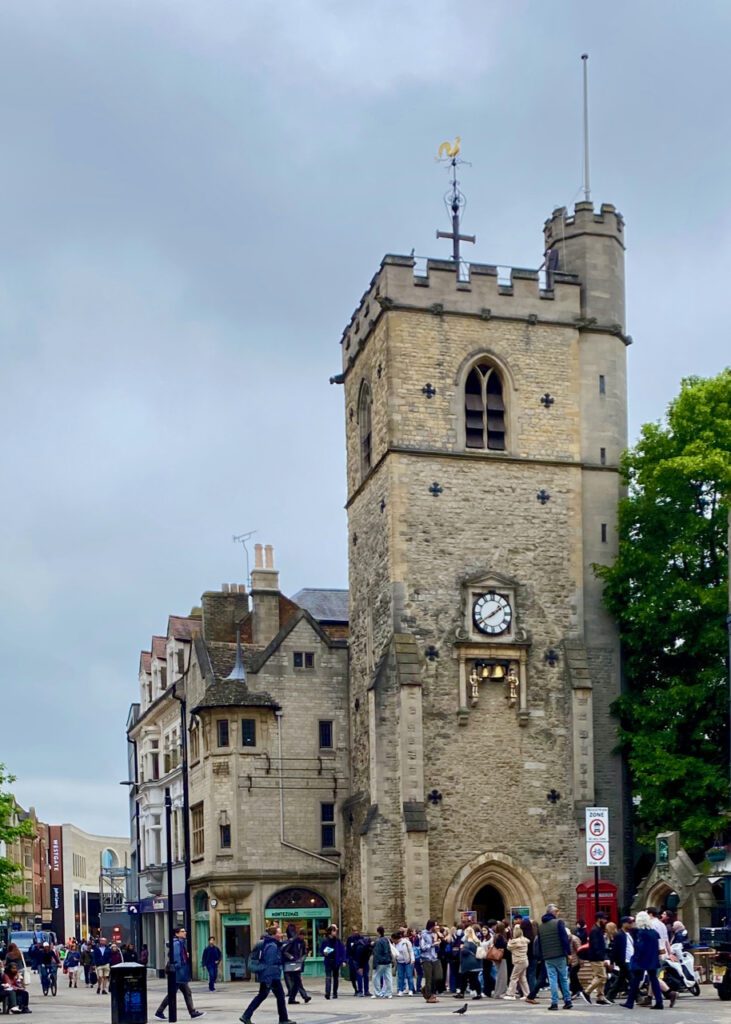
Carfax Tower remains a main meeting place in the city. It is stop 8 on the City Sightseeing Bus Tour, and where the guides (there’s an in person delivery every hour) gather before taking the next tour.
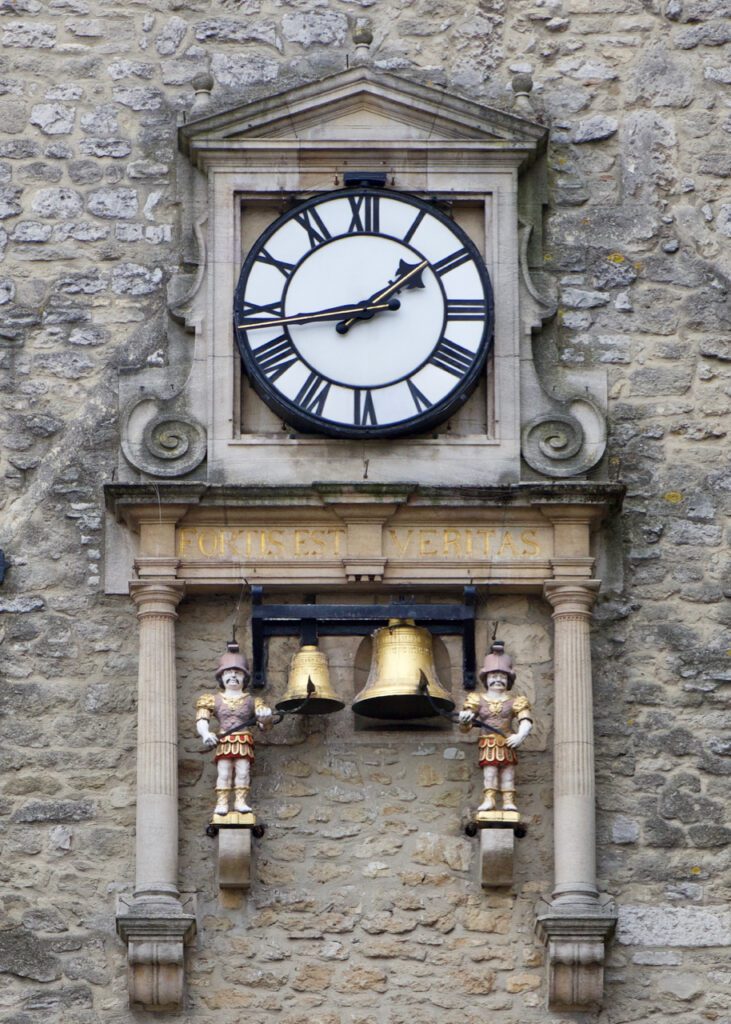
The Carfax Quarterboys chime every quarter hour.
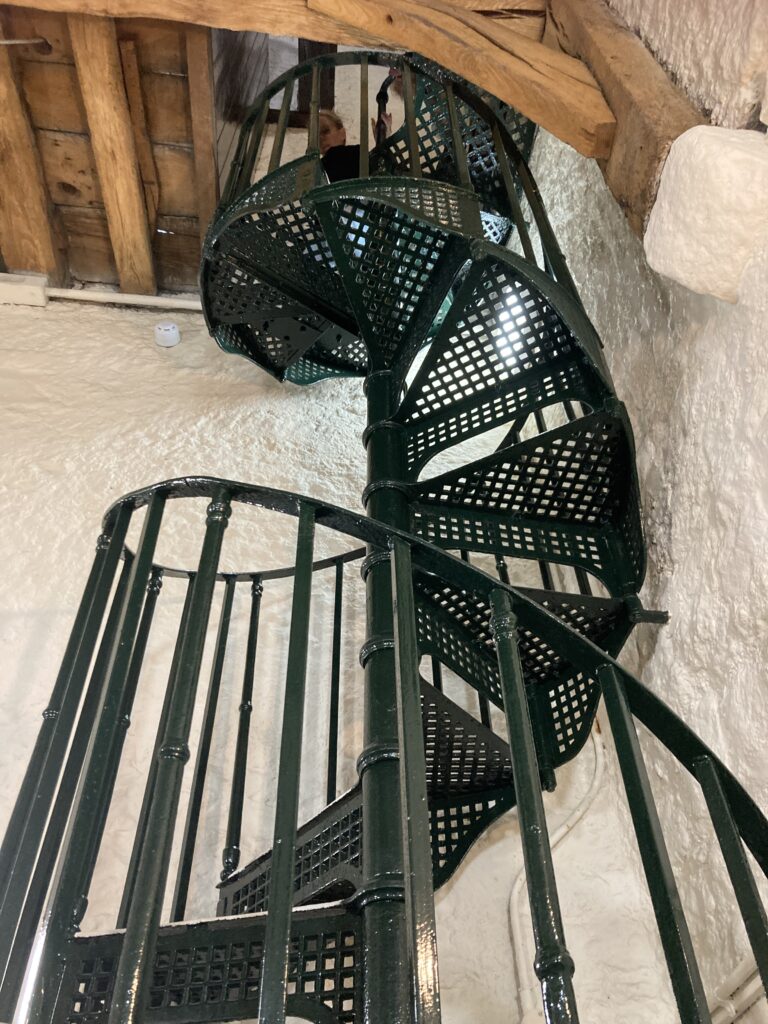
Some of the 99 steps to the top
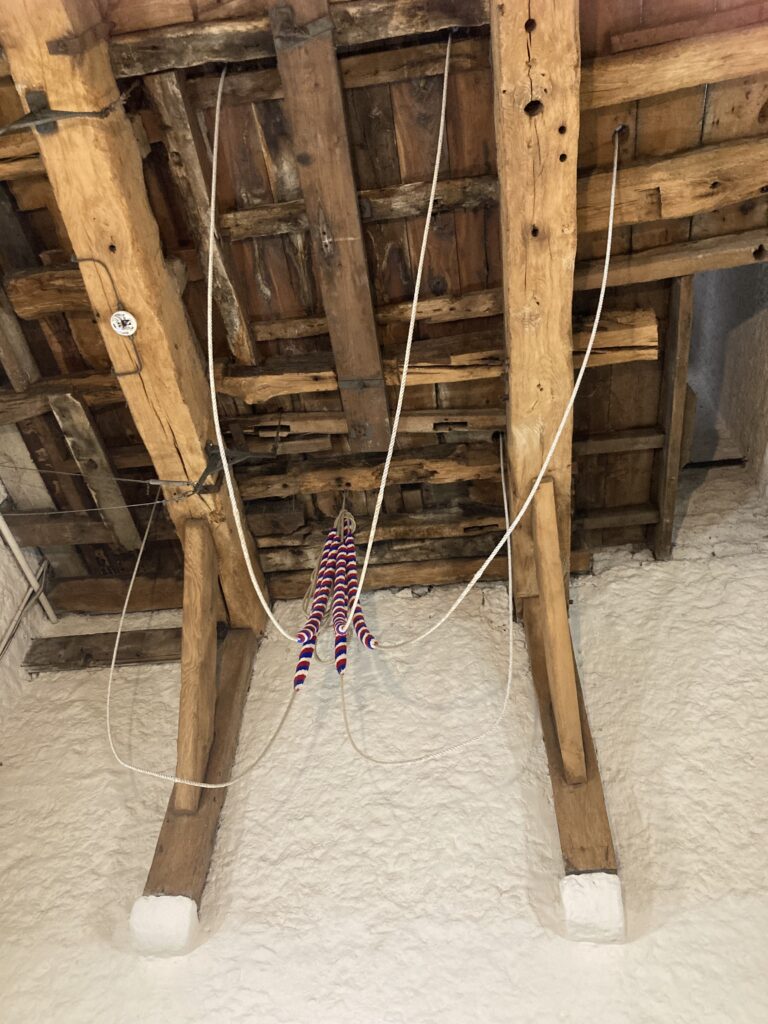
The ring of six bells dating from the 1600’s.
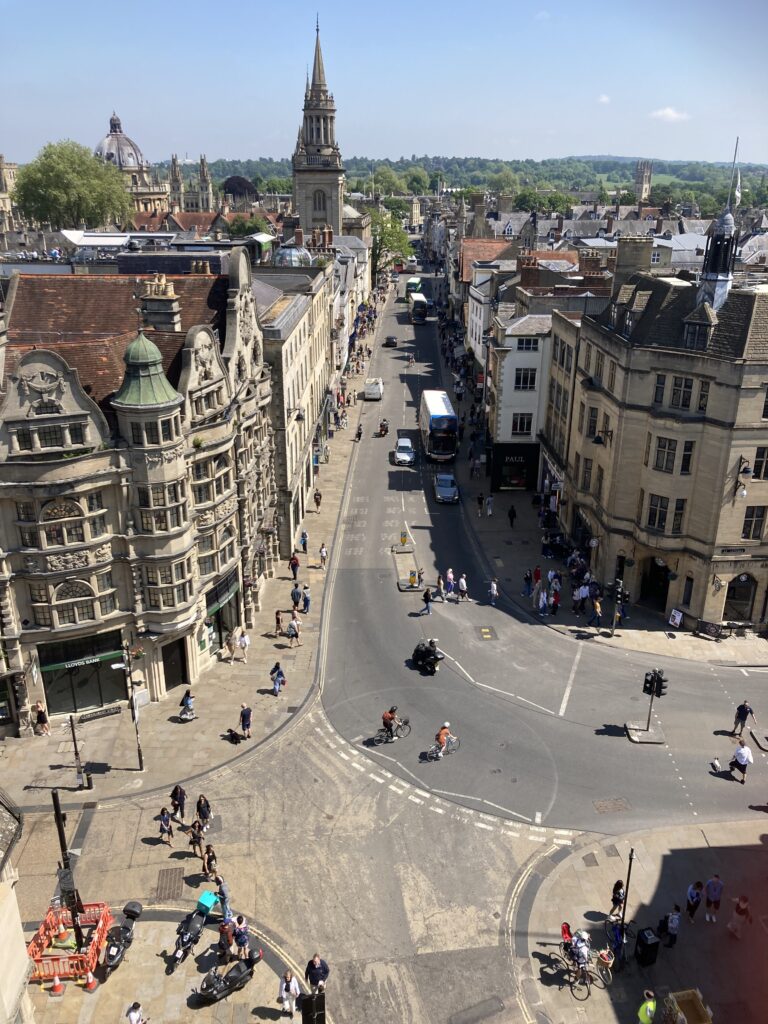
A clear view of the Carfax ‘fourways’ from above looking east along the High Street
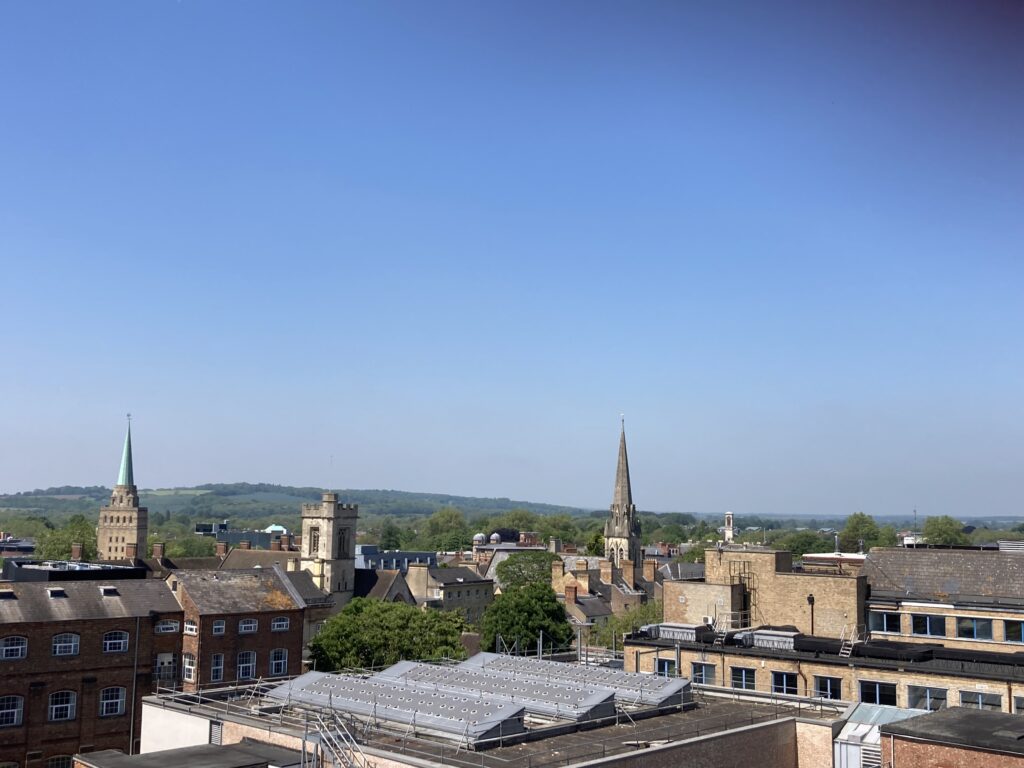
Looking west past Nuffield College towards Cumnor Hill
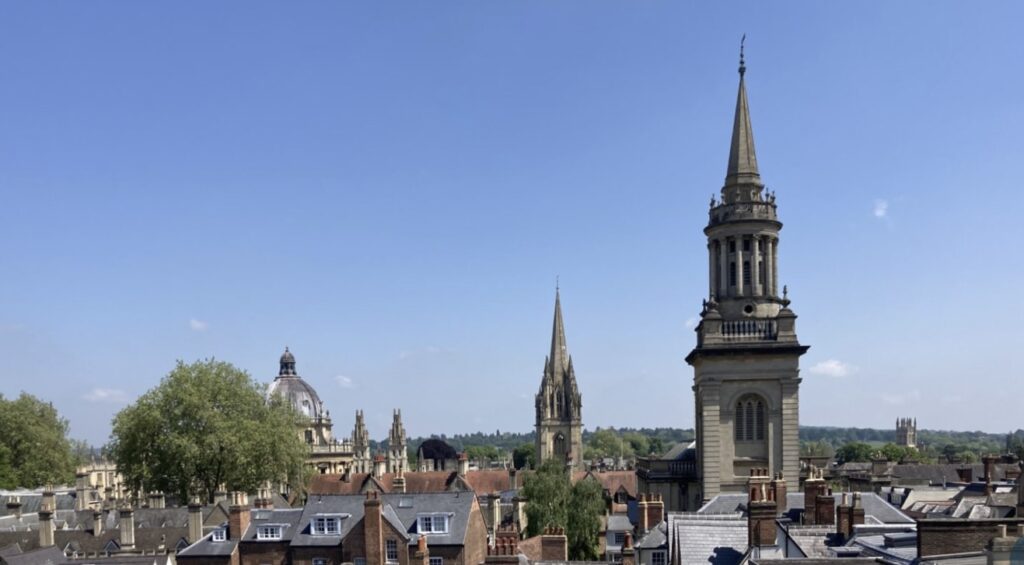
From right to left, Magdalen Tower in the distance, The Church of All Saints (now Lincoln Library), the University Church of St Mary the Virgin, the turrets towers of All Souls and the dome of the Radcliffe Camera.
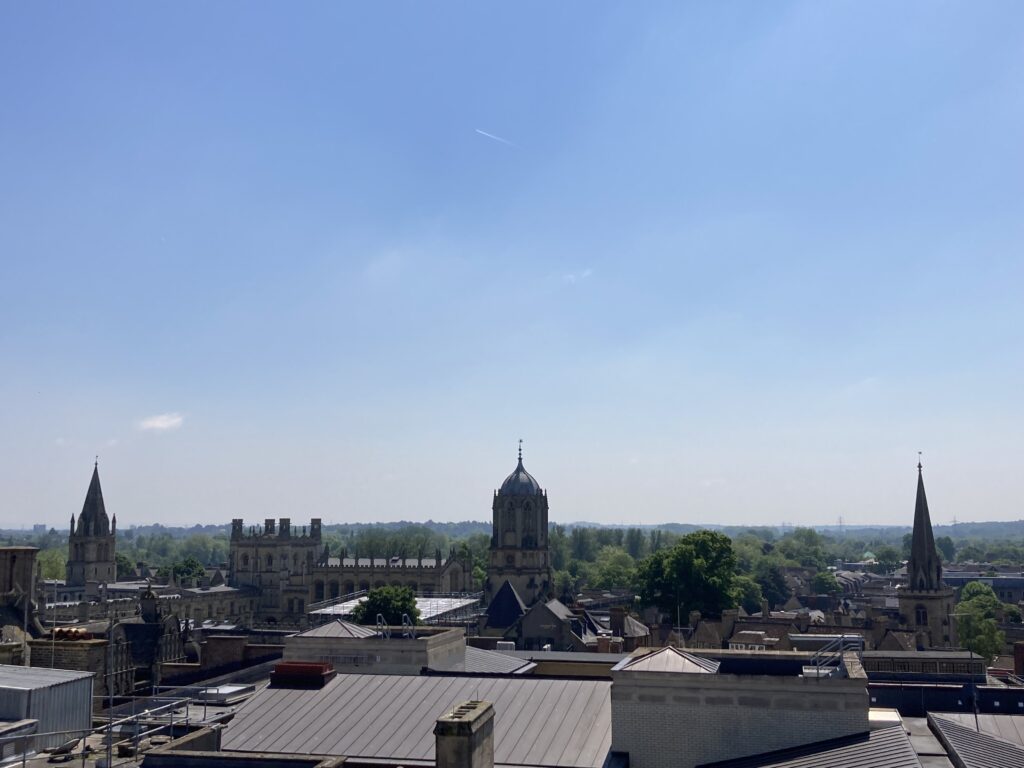
Looking south – Christ Church dominates.
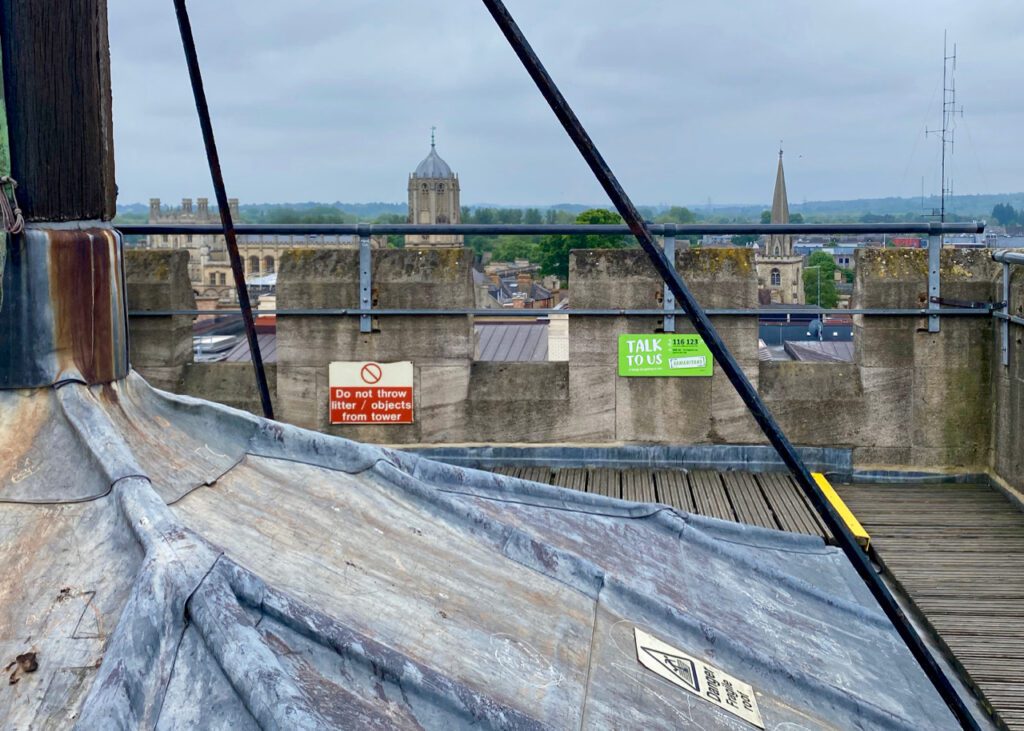
Ever since the tower went up things have been thrown from its top. Edward 3 was so worried that he reduced the height of the tower by 20 feet in 1340 after some of the worst of the town and gown skirmishes. There are signs for the Samaritans all the way round.
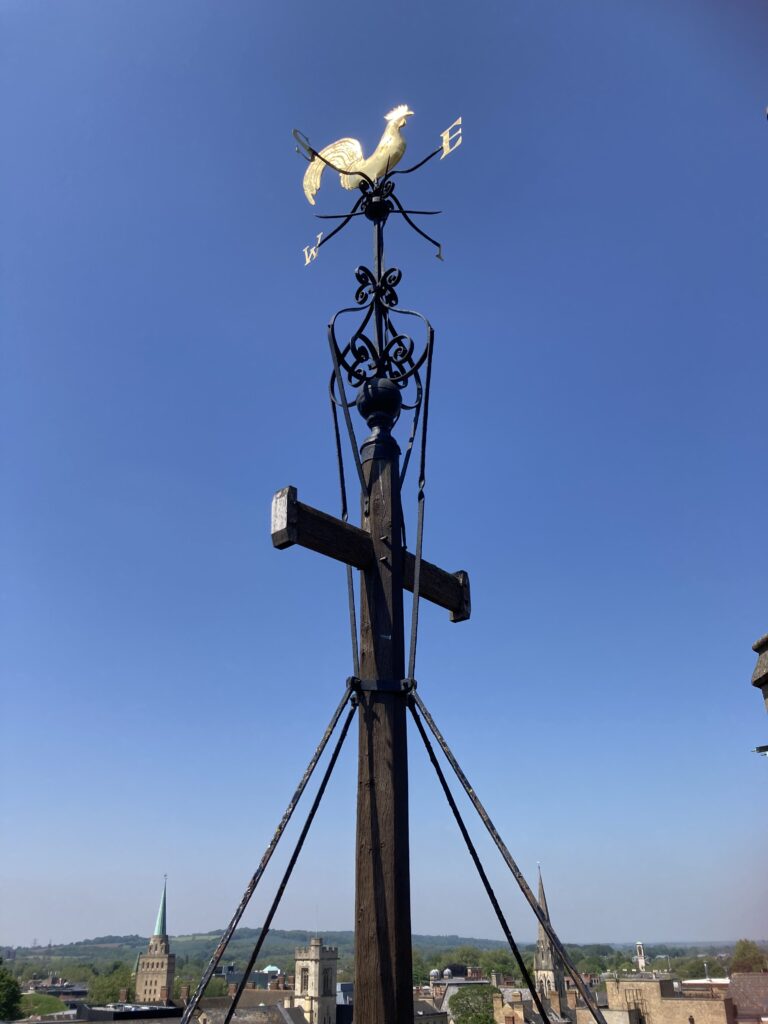
A rooster is often seen on church weather vanes – referring to Jesus’ prophesy that Peter will deny him three times before the cocks crows the morning after the Last Supper
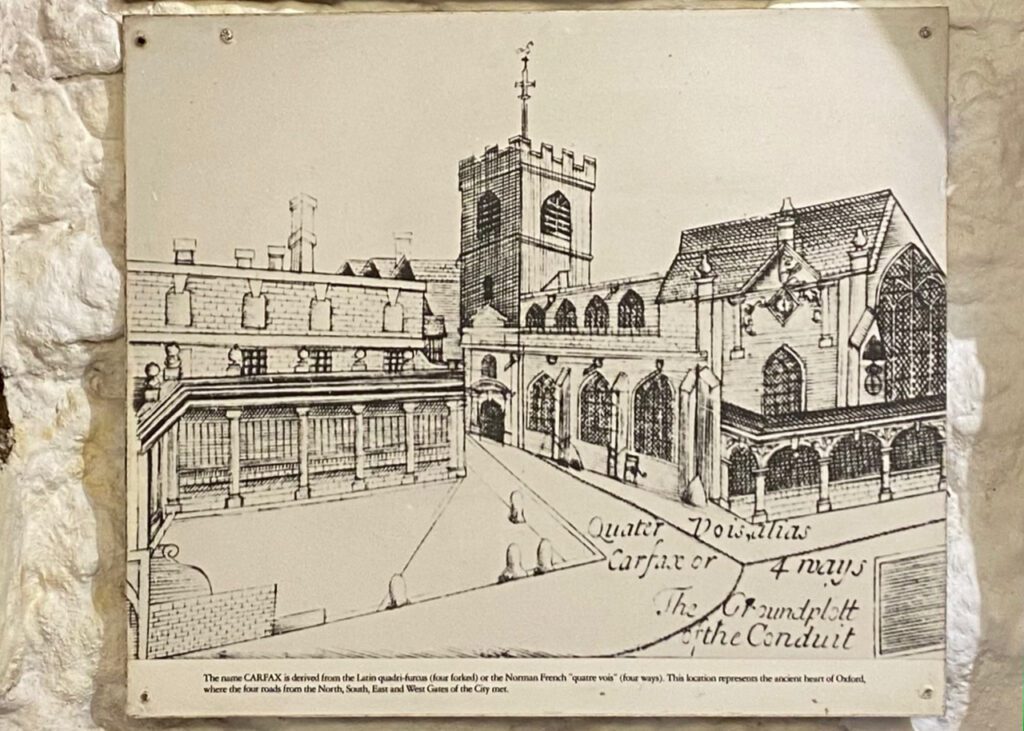
This picture on the walls of the tower shows a drawing of the medieval church with the penniless bench in front and the ground plot for the Conduit.
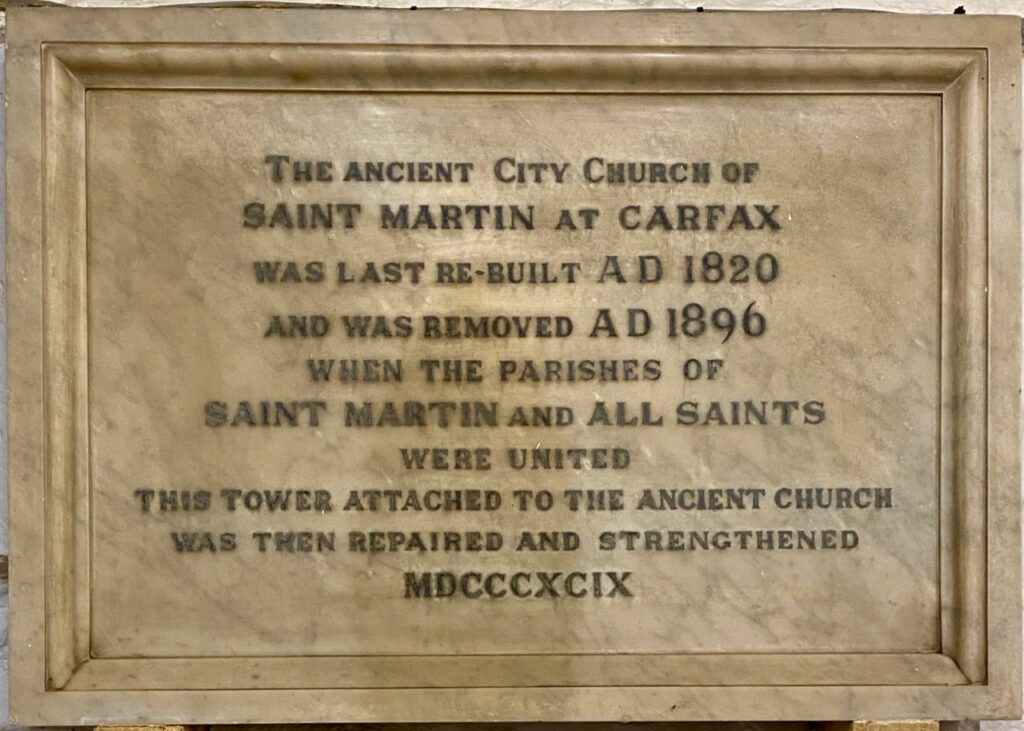
The church demolished in 1896 was the second church to be removed from the site. The first church lasted from 1122-1820, but there was almost certainly a church before that dating back to the 11th century.
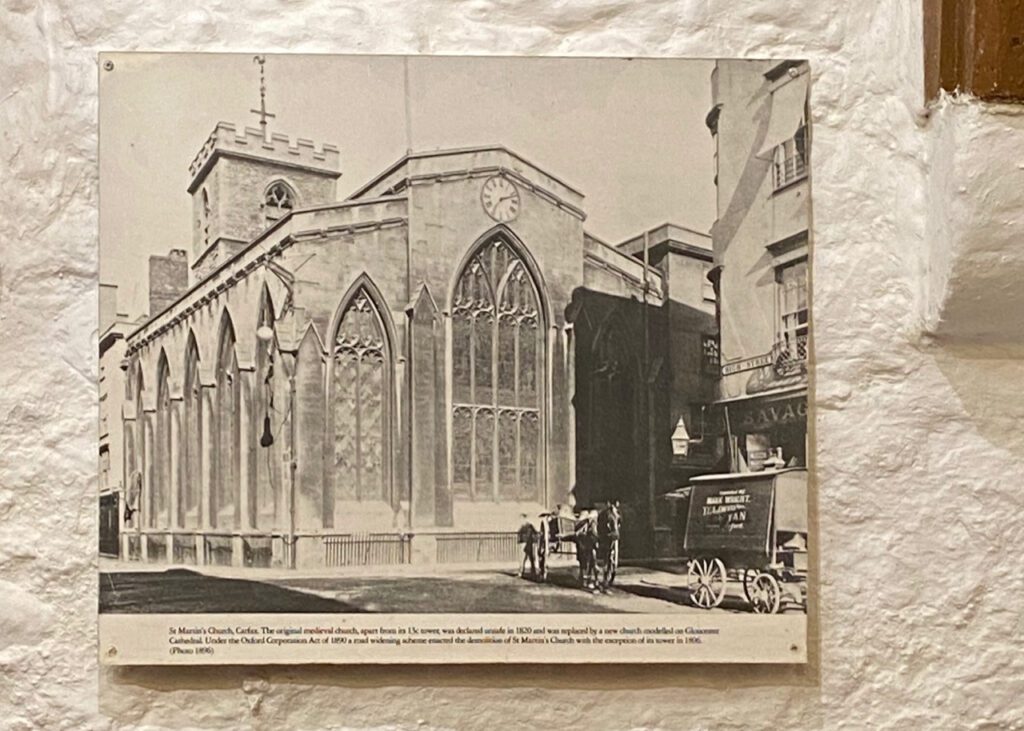
This was the vast church built in 1820 modelled on Gloucester Cathedral.
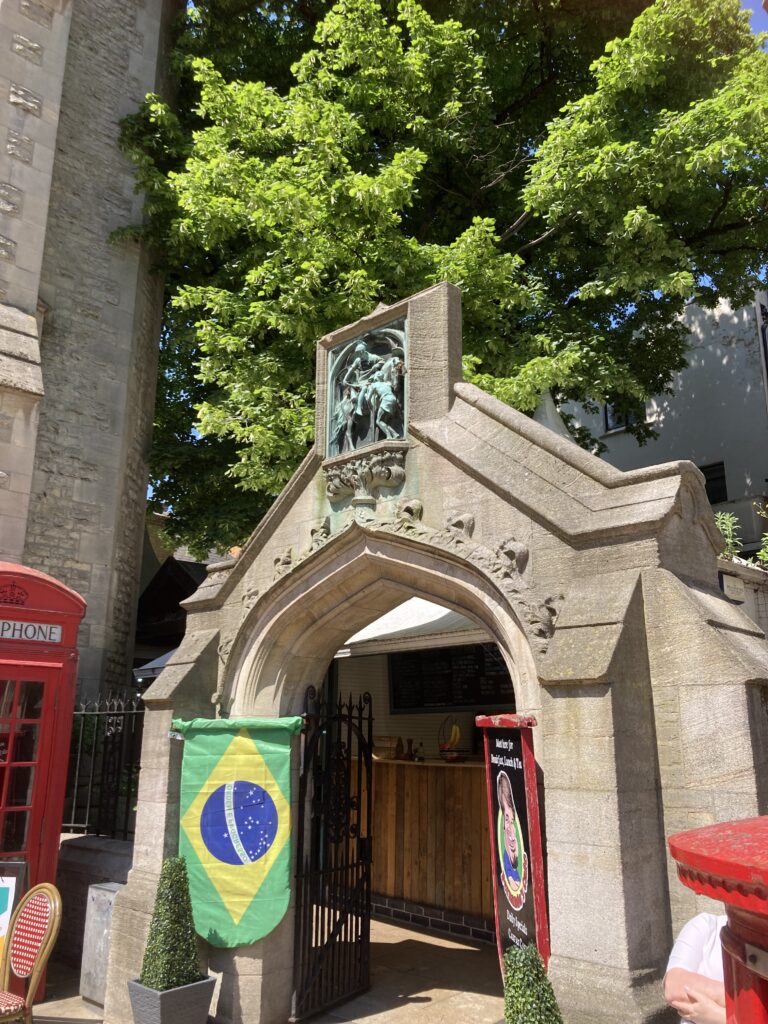
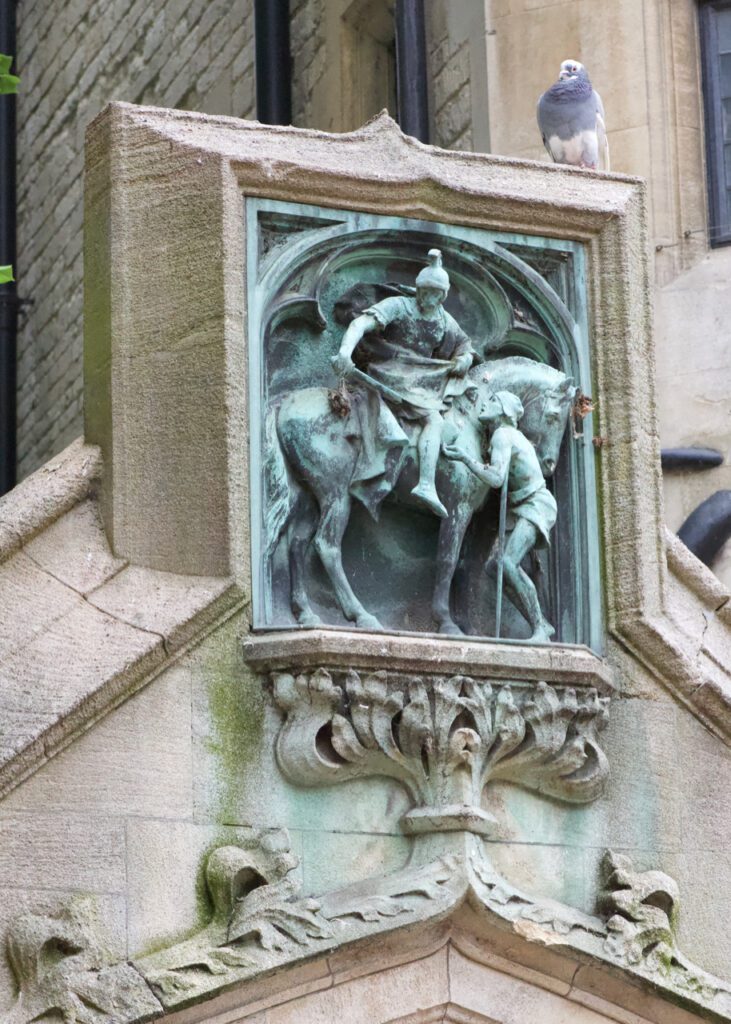
The gothic gateway of St Martin, was designed by HT Hare the architect of the Town Hall to lead to a garden and what was left of the old church yard after the church was demolished. It is now a cafe. The bronze sculpture is of St Martin of Tours, to whom the old church was dedicated. It shows him cutting his cloak in two in order to clothe a poor half naked man. St Martin became the patron saint of beggars, and this is thought to have been why the ‘penniless bench’ was so named.
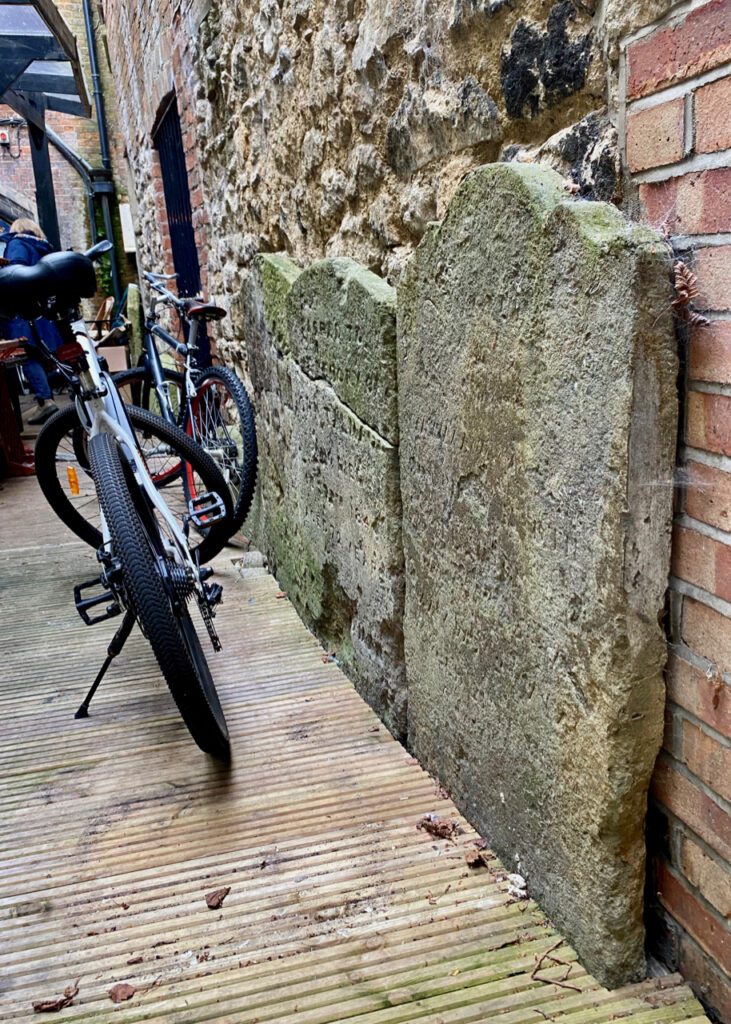
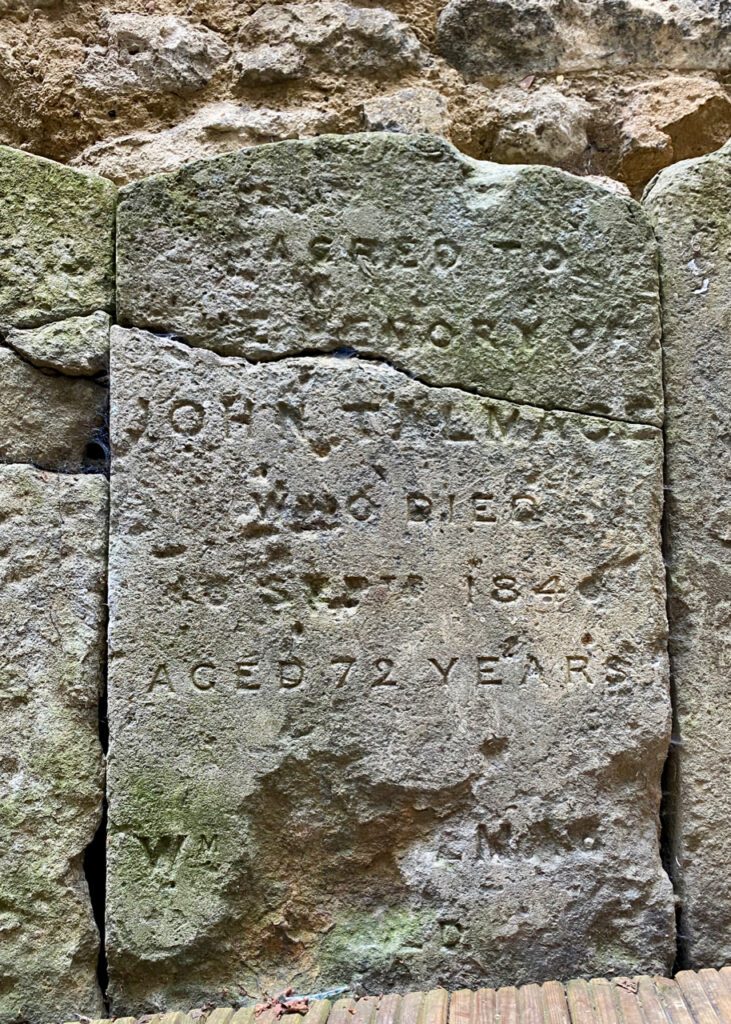
Some of the old graves at the back of the cafe, a space now used to house bikes and bins.
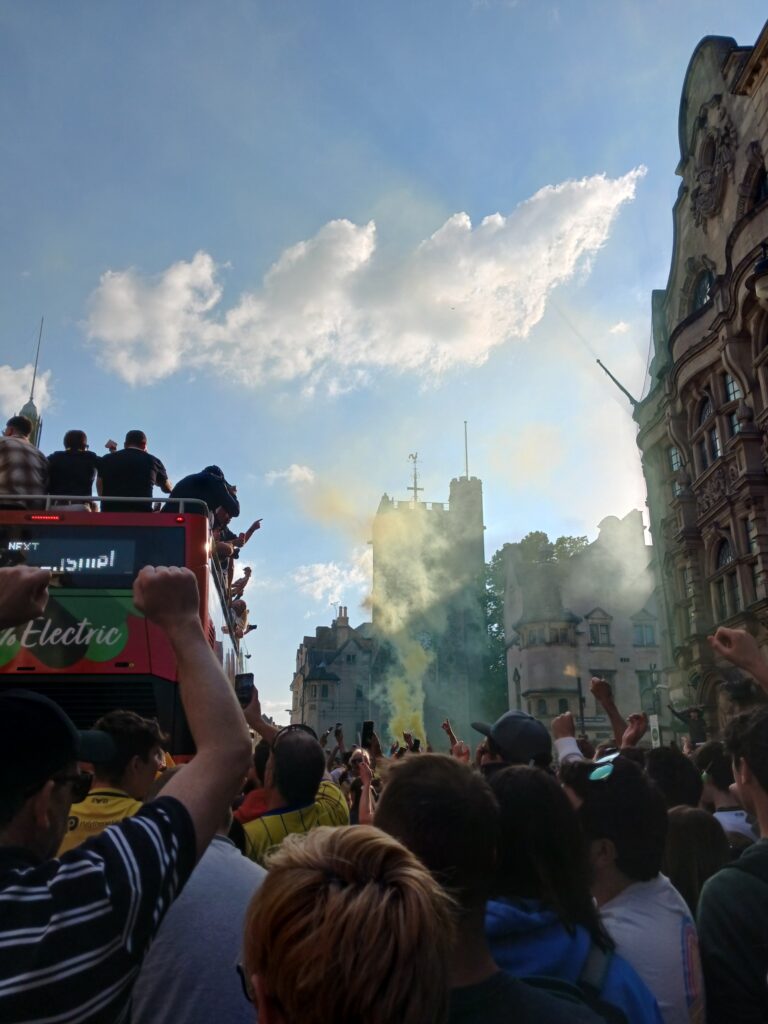
Oxford United supporters celebrate at Carfax Tower last week.
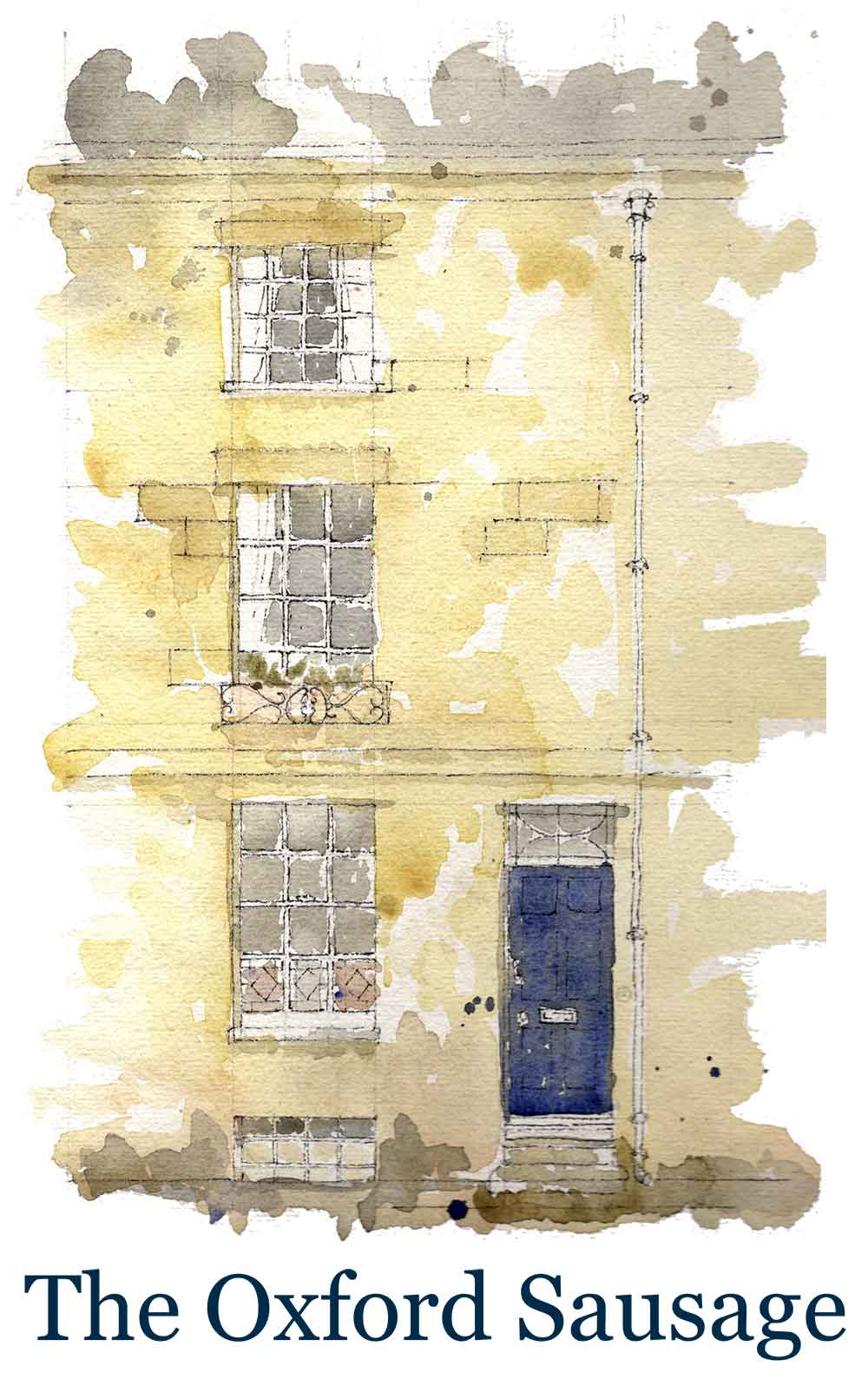
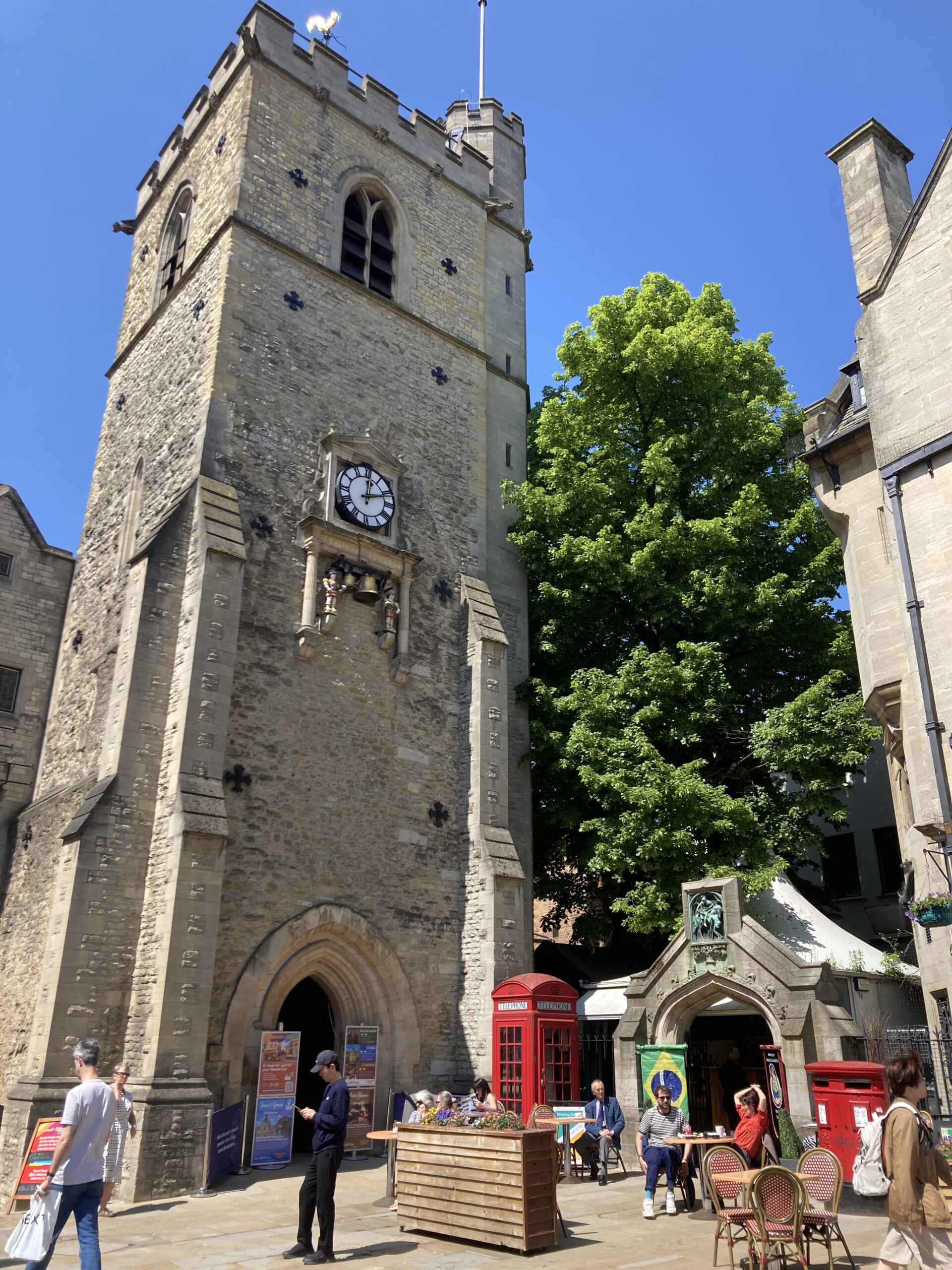
2 Comments
Join the discussion and tell us your opinion.
[…] Meeting up at Carfax Tower […]
[…] Meeting up at Carfax Tower […]